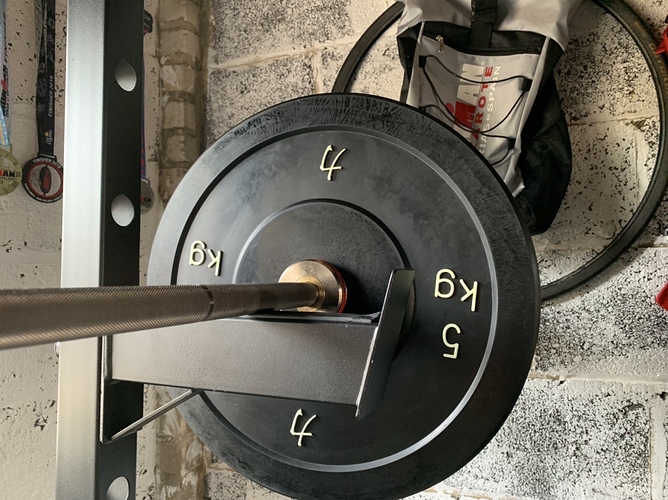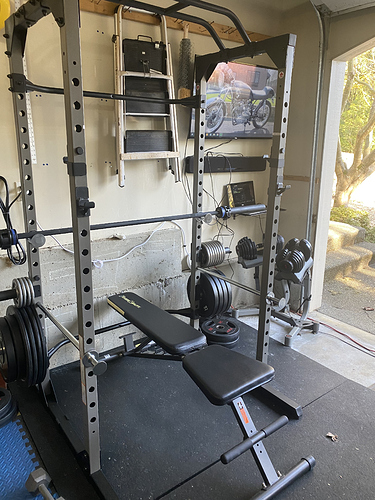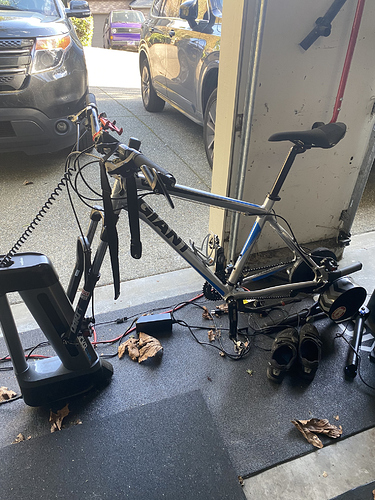Thanks everyone, this has been a super helpful thread. As an old (>50) guy, I think weights are critical for bone health. When I started increasing my squats and deadlifts, it was during a Build and I was so fried (trying the “hard days hard” approach) that I couldn’t get any of the VO2 sets done and felt like I was going backward.
So I thought about splitting everything up entirely: like taking a week for lifting only, then 2 weeks of TR, etc. Is that just a terrible idea? Am I better off just HTFU and hope to adapt better to the weights but make sure I’m consistent with both TR and weights (with different phases depending on time in the season)?
My weight lifting isn’t too sophisticated: squats, hex bar deadlifts, some plyo lunges/squat jumps, core and some other smaller muscle stability. But, no matter how I do it, I have DMOS for 2 days (48 hours always the worst) after, and so I do worry that the weights are going to be very detrimental to my ability to complete TR workouts, at least beyond the SS level.
How many days a week are you lifting lower body? Not sure how much time you have, but I find Sundays are the best day to lift weights for me. I lift in the morning, then do a sweet spot or endurance ride in the afternoon. I’ve also experimented with lifting on a Saturday afternoon after my group ride, then doing endurance on Sunday, giving me a couple of days in between lifting and Vo2s on Tuesday.
You should also tweak what exercises you perform during a given workout, and your total volume. I know personally that if I do Squats and Deadlifts in the same day, I am absolutely smoked (and if I had to do plyos the same day, I would need to be wheeled out of the gym)! If you are lifting multiple times a week, try doing one workout with squats and the second workout with trap bar deadlifts as the primary focus, then throw in some accessory work if gyms ever open again!
Great idea. I was trying to minimize my recovery days by getting it all in at once. My plan was to lift 2-3 x/week during my non-TR week, with the only TR workouts being sprint workouts that I made via WC (based on University of Ontario studies). But perhaps I will lift more often but for less time and less exercises, and be more consistent with TR rather than separate weight weeks and TR weeks…
Don’t be too afraid of DOMS! Your body can take more than you think. Soreness is normal and should be considered as a form of adaptation (if the other factors like nutrition and rest are well addressed). You’ll see that often you can ride through the soreness (if it’s normal soreness felt in the muscles, not ligaments etc). After years of strength training I still get sore sometimes (like you 48h after). Best tip would be to keep the day after easy or completely off
Hmm I’m not sure, sound to me like the worst of both worlds with neither strength or cycling getting enough attention. How about macro cycles - focus on strength in winter, bike in summer?
What kind of progressions are you doing to get DOMS?
BTW I finally have a home set up so can use - I actually found hens teeth - an Olympic bar for sale in the UK! ![]()
I still need 1.25 and 2.5 plates so I can start StrongLifts again, but I got my first session (workout B) in today ![]()
That’s a “Bastard Bar” from strength shop.co.uk ![]()
I’m not sure I know what “progressions” means?
I start with a body weight set to warm up, then additional 2-3 sets. For goblet squats, I get to a weight where I can do 10 reps. For deadlifts, a weight where I can do 2-3 reps.
But I agree that, right now, I feel like I’m not gettting good focus on the cycling. And I like macro cycles, but what I tend to do in the summer is no lifting at all, which I don’t think helps my DOMS when I start up again…
I’m pretty new to this stuff, only started in October so Im looking at it from my limited point of view and may be out of whack as a consequence.
StrongLifts starts extremely light - just the bar for me, and progresses slowly 2.5kg per workout so over 12 weeks you can be lifting really heavy but I’ve felt no DOMS at all getting to squatting just over my body weight (80kg) and deadlifting 100kg. Novice levels I know but still feel pretty heavy to me.
I did have a wrist issue upthread but that was a technique flaw and easily fixed.
I find that when I’m just getting back into a lifting routine, I’ll have DOMS for the first week or two, but after that it goes away even when I’m increasing the weight. Maybe you just need to consistently lift and work through the DOMS instead of resetting, even if that means lifting less volume/weight/whatever each session.
That’s been my experience though, maybe someone with a little more scientific knowledge can chime in.
DOMS is different for everyone, but for a lot of people crippling DOMS goes away after a few weeks of consistent lifting (on the flip side, it has to be said, for some people DOMS is just part of lifting). Insufficient fueling (both carbs and protein) can also make it worse, for a lot of people. For me personally, 2 weeks off is right on the edge of whether I’ll have it bad the next time I lift or not, so I would worry about taking 2 weeks off after every week I spent lifting. I would just never adapt.
Is it worth trying for you? I’d say “maybe.” If you’re going to have bad DOMS no matter what, then maybe the breaks from lifting (and having DOMS) is better. But I’d suggest trying to adjust first, and see if you can get into a routine that doesn’t cause DOMS first.
My suggestion for getting there: continue with your TR plan without breaks. Spend a few weeks doing weights consistently but with light weight (i.e. for goblet squats, do 2-3 sets of 10 reps with a weight you feel you can do for 30 reps - but don’t actually keep going). If you can do that workout 3x in a week with manageable soreness after, start increasing the weights - but slowly. Your goal would be to see the weight go up, but feel about the same or less soreness 24-48 hours after the workout, consistently.
If even taking this slow and careful approach doesn’t reduce or eliminate the DOMS, then maybe consider other approaches, but the key here is consistency and patience, so give it time to see how it goes.
Does anyone know if there is a protocol for partial squats?
My son has a teenage condition where his tendons haven’t grown in sync with the rest of his legs so he can’t crouch properly yet but we want to encourage development. I’m thinking partial squats may still be able to strengthen the whole posterior chain?
Hmm I would have to say that maybe a PT would be the best person to answer and would be able to give specifics based on the condition.
If he still has strength but is limited in range of motion then maybe box squats would be good so that there is a hard limit to how deep he can go and you can stack things on a box to make the height higher or lower. You could also sub squats for things like lunges, step ups, split squats, etc. Those are more quad dominant than maybe your typical back squat but paired with RDLs, glute bridges, hip trusts, etc would give a pretty complete lower body work while limiting the ‘crouch’ position you say is a limiter.
Obviously this is all with the caveat that you have a good grasp of what his range of motion is that he can do with strength and control.
Edit: Additional possible strength movements:
- Weighted sled drags and pushes
- tire flips
Not sure if this has been covered or not in this thread but curious if when you have a recovery week on the bike if you also gives the legs either a rest or lighten the load when lifting weights?
@stickmandj from the beginning of the thread in sep ‘18
I think it will depend very much on how heavy you’re lifting, how frequently and what your goals are.
Not to sound harsh, but this seems like an awful specific question that ask a bunch of bike riders on the internet. Has your child’s physician ok’d weighted squats? If so, has the physician referred your child to a physical therapist to maximize your desire to “encourage development?”
Yeah but that’s why I’m asking about partial squat routines - not medical advice. I added that context to avoid any queries about choosing partial squats over back squats and range of motion and so on.
I think box squats are the first port of call ![]()
Some time ago I saw a “100 reps” routing in a magazine and thought I’d have some of that. I was OK with nearly everything but 100 calf raises left me forced to walk on tip-toe for two days. My mates found it hilarious and called it “high heel syndrome”. Not a mistake I made again.
I’m doing StrongLifts 5x5 as well as Low Volume Sweet Spot Base. I think I’m OK doing both as due to lockdown I’m expending less energy each day than normal. This is my rack:
and my bike, which is pointed at the big TV of course:
Hiya! Wondering if anyone has advice for starting strength training alongside the SSBHV plan- or if i’m more or less doomed to fail ![]()
I’d really like to stay on the HV plan as I’ve had consistent success with those in the past, and my focus is still on cycling. However from all accounts strength training is something I should stop putting off. ![]() only problem is, predictably, I have crazy DOMS after not lifting in so long. Wondering if anyone would be able to share their approach to strength alongside a HV plan? Will I ever be able to sit on the toilet again?
only problem is, predictably, I have crazy DOMS after not lifting in so long. Wondering if anyone would be able to share their approach to strength alongside a HV plan? Will I ever be able to sit on the toilet again?
I’m not on a HV plan, more like MV in the season and LV during the winter.
Based on my n=1 experience mixing strength training, skiing (which is pretty anaerobic and strength focused), and SSB, I think you would benefit significantly from reducing cycling volume for a month while you shift focus to strength training. DOMS when you first start strength training is a real thing, and it’s impact on RPE of on the bike workout is no joke. After a few weeks of strength training, you will adapt to the new training stimulus, and the DOMS will go away. Then you can start increasing the cycling volume working back up to a HV approach, while maintaining the strength workouts.


